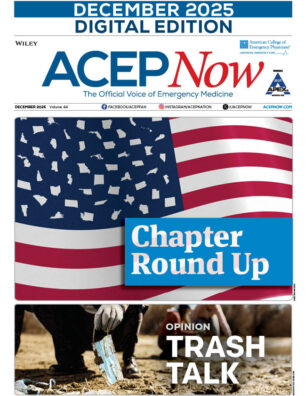A caravan of trucks traveled up I-75 carrying precious goods. As the colossal collection of cargo approached the scenic Maumee River near Toledo, the lead driver failed to realize that traffic had slowed to a pace only seen during the cleaning of empty hospital rooms. Being from out of town, he was unaware of the stampede to the local convention center to receive free cell phones from the federal government. The traffic had backed up for a quarter mile. With nothing left to do, he down-shifted and pushed with all his might on the brake pedal. Soon enough the 18-wheeler jack-knifed and the rest of the caravan followed suit. Before anyone could dial 911 on a free phone, five tractor-trailers plunged into the river. EMS and Coast Guard arrived quickly. They navigated the swift current to reach the jumble of rubber and steel. Miraculously, the drivers survived, but the cargo of essential intravenous medications descended to the murky depths of the dredged waterway.
Explore This Issue
ACEP News: Vol 31 – No 05 – May 2012Fish on the downstream side began to act strangely. The lidocaine was absorbed first, causing many to have seizures. Or possibly they were just swimming fast. In the commotion, it was hard to tell. Luckily, there was plenty of ondansetron to prevent postictal vomiting. Unfortunately, the fish absorbed the furosemide next. Between the seizing and all the micturation, those fish didn’t know up from down. Plus, they couldn’t find the “peeing” section of the river. To make matters worse, the labetalol began to work and wiped out what little blood pressure was left after the furosemide. As the etomidate was absorbed into the listless pisces, they turned belly up and drifted to Lake Erie, where their remains were eventually eaten by the bottom-feeding lawyer fish.
The big winners in the whole mess were the upstream carp, who managed to salvage the unbroken bottles of etomidate. They hope that when the government decides to give away electric cars, a truck carrying syringes and needles will crash in a similar fashion.
Meanwhile, on land, hospitals across the Midwest experienced shortages of all these drugs. Pharmacists hastily developed rationing plans and squeezed every supplier for their last vials. When interviewed, hospital administrators vacationing in Mexico were quick to point out that there was a special on etomidate at the Walmart in Puerto Vallarta and they were flabbergasted by all the fuss. Several promised that they would check into the situation after finishing their piña coladas.
For blood pressure control, doctors resorted to showing gory movie scenes and pictures of Roseanne Barr, hoping to induce vagal reactions. The old technique of using rotating tourniquets was revived for the treatment of pulmonary edema. One patient remarked that the limb numbness was pretty bad but it made him forget about his dyspnea.
Replacing lidocaine was more problematic. Some physicians tried injecting plain saline. This worked briefly, but for longer procedures it proved no better than hand holding. Doctors at many hospitals resorted to whacking a thumb with the PDR to distract patients from the pain of suturing. Saying, “Come on, be a man,” over and over again seemed to have a positive effect as well.
At many hospitals, propofol was already in short supply and ketamine was forbidden in the ED. The loss of etomidate caused emergency physicians to be creative in their efforts at procedural sedation. Some tried showing a tape of the latest State of the Union address. Sleep came quickly; however, it was short-lived and was followed by crushing depression. One patient was nearly killed when he ran into traffic screaming, gown flapping in the breeze, and waving the New Hampshire state flag. Eventually chloroform became the new standard for sedation but not without a learning curve. Several residents required brief ventilation by bag valve mask. One commented that it was his best sleep since the lecture on psychiatric emergencies.
That’s my story and I’m sticking to it.
Dr. Baehren lives in Ottawa Hills, Ohio. He practices emergency medicine and is an assistant professor at the University of Toledo (Ohio) Medical Center. Your feedback is welcome at David.Baehren@utoledo.edu.
Pages: 1 2 | Multi-Page





No Responses to “The Explanation for Drug Shortages”